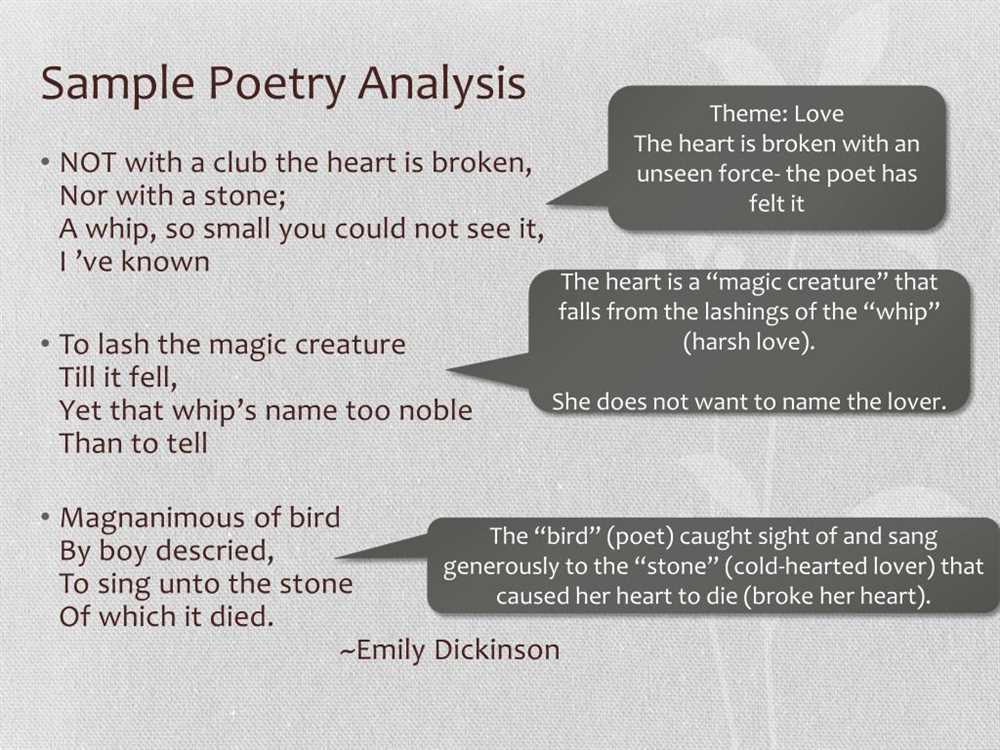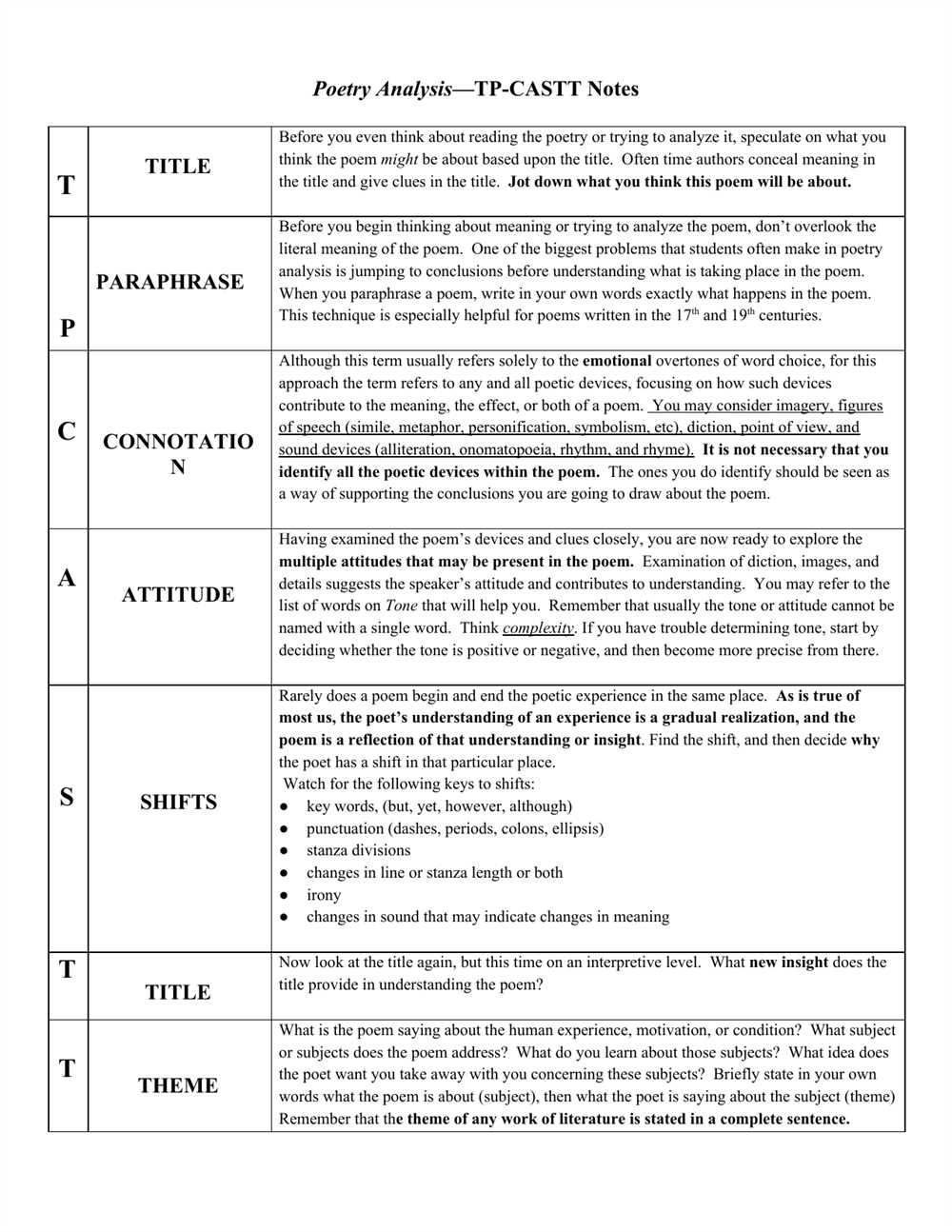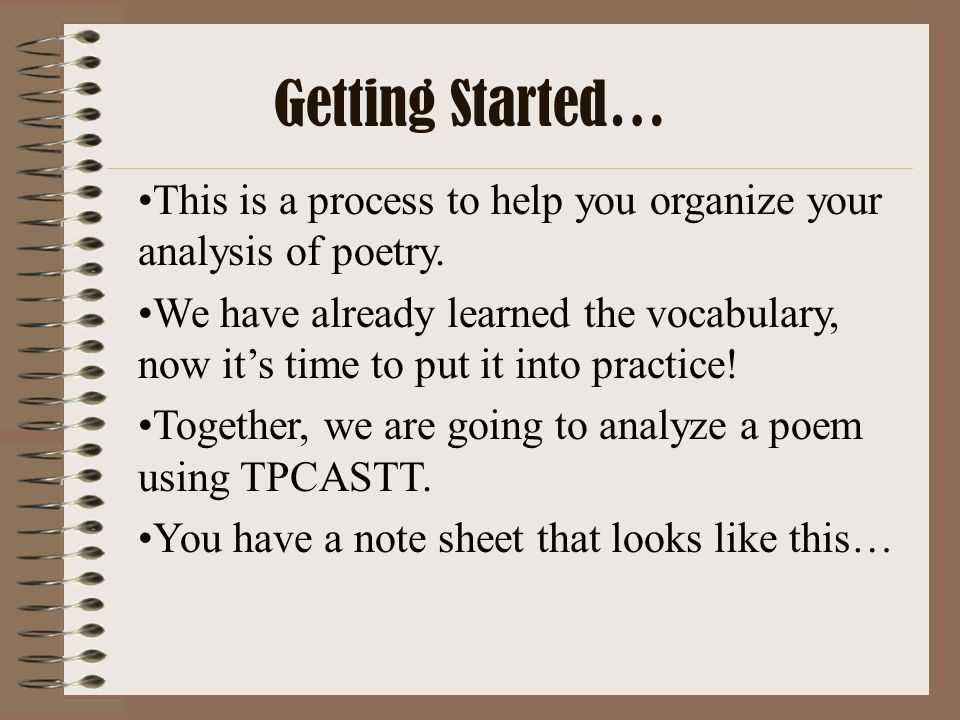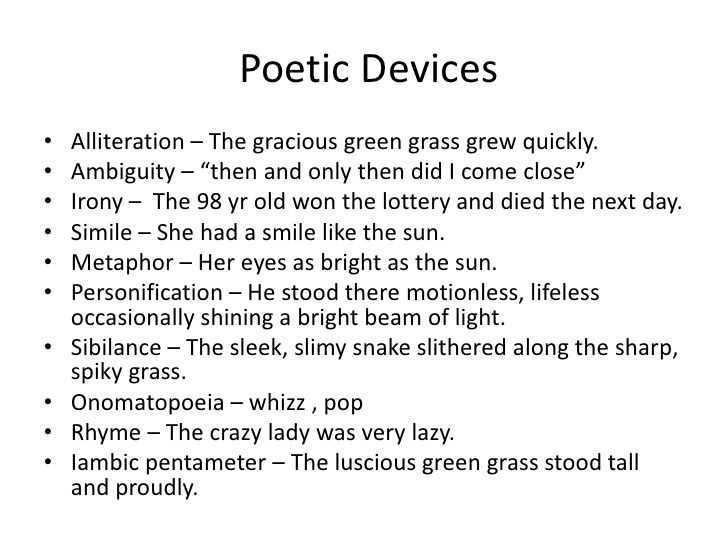
When it comes to analyzing poetry, one of the most commonly used methods is Tp castt. Tp castt stands for Title, Paraphrase, Connotation, Attitude, Shifts, Title (again), and Theme.
First, let’s start with the title. The title of a poem can often give us clues about the poem’s subject matter or themes. By analyzing the title, we can start to form a hypothesis about what the poem might be about.
Next, we move on to paraphrasing the poem. This involves rephrasing the poem’s lines in our own words to get a better understanding of the literal meaning. By paraphrasing, we can begin to uncover any hidden meanings or symbols within the poem.
After paraphrasing, we delve into the connotation of the poem. Connotation refers to the emotions, feelings, and associations that certain words or phrases may evoke. By paying attention to the connotation, we can gain insight into the poem’s deeper meaning and the poet’s intentions.
The attitude of the poem is another important aspect of analysis. Attitude refers to the tone or mood that the poet conveys through the poem. By examining the attitude, we can determine whether the poet is being serious, playful, or any other range of emotions.
Next, we look for any shifts in the poem. Shifts refer to changes in the poem’s tone, subject matter, or perspective. By identifying shifts, we can uncover any hidden messages or changes in meaning that the poem may be trying to convey.
Afterwards, we revisit the title. By comparing the title to our newfound understanding of the poem, we can reassess our initial hypothesis and see if our interpretation has changed.
Finally, we arrive at the theme. The theme is the central idea or message that the poet is trying to convey through their work. By analyzing the title, paraphrasing, connotation, attitude, shifts, and revisiting the title, we can arrive at a deeper understanding of the poem’s theme.
By using the Tp castt method, readers can engage with poetry on a deeper level and uncover the rich layers of meaning that lie within.
What is Tp castt?
TP-CASTT is a popular method used to analyze and interpret poetry. It is an acronym that stands for Title, Paraphrase, Connotation, Attitude, Shift, Title (again), and Theme.
Title: The first step in the TP-CASTT analysis is to carefully examine the title of the poem. The title can provide important clues about the subject, tone, or overall meaning of the poem.
Paraphrase: After analyzing the title, it is important to paraphrase the poem, line by line, in order to gain a better understanding of the literal meaning. This step helps to break down complex language and identify any hidden meanings or symbols.
Connotation: In the connotation stage, the reader delves deeper into the poem to uncover the emotional and figurative meanings. By exploring the use of imagery, metaphors, and other literary devices, the reader can gain insight into the underlying emotions and messages conveyed in the poem.
Attitude: Understanding the attitude or tone of the poem is crucial in deciphering the poet’s perspective or feelings towards the subject matter. This step helps to identify if the poem is written with sarcasm, nostalgia, anger, or any other specific emotion.
Shift: The shift refers to any changes or shifts in the tone, perspective, or subject matter that occur within the poem. Identifying these shifts can help to uncover the deeper meaning or message of the poem.
Title: Upon revisiting the title at the end of the analysis, the reader can reflect on how the initial understanding of the poem has changed or evolved. This step allows the reader to make connections between the title, the analysis, and the overall themes in the poem.
Theme: The final step is to determine the theme or overarching message of the poem. By examining all the previous steps, the reader can identify common patterns, symbols, or ideas that recur throughout the poem and derive a deeper understanding of its meaning.
How to Use Tp castt for Poetry Analysis
Poetry analysis can be an intimidating task, but by using the Tp castt method, you can break down the poem and gain a deeper understanding of its meaning and structure. Tp castt stands for Title, Paraphrase, Connotation, Attitude, Shifts, Title (again), and Theme. This method provides a structured approach to analyzing poetry, guiding you through each step to uncover the layers of meaning within the poem.
Title: Begin by carefully reading the title of the poem. Titles often provide essential insights into the central theme or message of the poem. Pay attention to any keywords or phrases that stand out, as they can offer a starting point for understanding the poet’s intention.
Paraphrase: The next step is to paraphrase the poem. This involves restating each line of the poem in your own words, line by line. By paraphrasing, you can ensure a clear understanding of the literal meaning of the poem. Take note of any recurring themes or symbols that emerge during this process.
Connotation: After paraphrasing the poem, it’s time to analyze the connotations of the words and phrases used by the poet. Look for figurative language, such as metaphors, similes, personification, and symbolism. Consider how these literary devices contribute to the overall theme or atmosphere of the poem.
Attitude: The next step is to identify the speaker’s attitude or tone in the poem. Consider the emotions or feelings conveyed by the words and the overall mood of the poem. Pay attention to any conflicting emotions or shifts in tone that may occur throughout the poem.
Shifts: Shifts refer to any significant changes in the speaker’s tone, attitude, or perspective. Look for changes in language, punctuation, or imagery that suggest a shift in the poem. These shifts often indicate a change in the theme or a turning point in the narrative.
Title (again): Revisit the title of the poem after completing the previous steps. Consider how your understanding of the poem has evolved and whether the title now takes on a deeper or more nuanced meaning. Reflect on how the title reinforces or challenges your interpretation of the poem.
Theme: Finally, identify the central theme or message of the poem. Consider all the elements you have analyzed so far and how they contribute to the overall meaning of the poem. Themes can be explicit or implied, and they often reflect universal human experiences or emotions.
By following the Tp castt method, you can systematically analyze a poem and gain a deeper appreciation for its artistic and emotional qualities. This method allows you to dissect the poem’s structure, language, and meaning, leading to a more comprehensive understanding of the poet’s intention.
Step 1: Title
In the first step of the TP-CASTT poetry analysis method, it is important to carefully examine the title of the poem. The title provides the reader with a glimpse into the central theme or subject of the poem. It may also provide clues about the tone, perspective, or purpose of the poet.
The title often serves as a starting point for the reader’s interpretation and understanding of the poem. It sets the stage and prepares the reader for the themes, emotions, or ideas that may be explored throughout the poem. Sometimes, the title may be straightforward, clearly stating the subject matter of the poem. Other times, it may be more abstract or symbolic, requiring the reader to delve deeper into the poem to uncover its meaning.
When analyzing the title, it is important to consider its literal and figurative meanings. Pay attention to the specific words used and their connotations. Look for any patterns or repeated words that may provide further insight into the poem’s themes or motifs. Consider how the title relates to the overall structure and content of the poem.
Overall, the title plays a crucial role in setting the stage for the reader’s interpretation of the poem. It can provide valuable context and hints about the poem’s deeper meaning. By carefully analyzing the title, the reader can begin to form a foundation for understanding the poem as a whole.
Step 2: Paraphrase
Paraphrasing is an essential step in the TP-CASTT poetry analysis method. It involves restating the poem’s content in your own words, capturing the main ideas and themes while providing clarity and understanding. By paraphrasing, you can delve deeper into the poem’s meaning and explore its nuances. It allows you to break down complicated or abstract language into more accessible terms, making it easier to interpret and analyze.
When paraphrasing a poem, it is important to pay attention to the poet’s word choice, tone, and imagery, as these elements contribute to the overall meaning of the poem. By rephrasing the lines and stanzas in your own words, you can uncover hidden layers of meaning and gain a deeper understanding of the poet’s intentions.
During the paraphrasing process, it is helpful to focus on the literal meaning of the poem first before diving into any figurative or symbolic elements. This approach allows you to establish a solid foundation of understanding and ensures that your analysis is grounded in the text’s actual content. By paraphrasing line by line or stanza by stanza, you can untangle complex ideas and concepts and make them more accessible to yourself and your audience.
Paraphrasing is not about simply replacing words with synonyms; it involves capturing the essence of the poem and conveying it in your own language. It is an opportunity to engage with the poem on a deeper level and to bring your unique perspective to the analysis. Through paraphrasing, you can uncover the underlying message, emotions, and themes of the poem, allowing for a more nuanced and comprehensive interpretation.
Step 3: Connotation
Connotation refers to the emotional or cultural associations that a word carries. Analyzing the connotation of words used in a poem can help us understand the deeper meanings and emotions the poet is trying to convey. It allows us to go beyond the literal or surface-level interpretation and delve into the subtext of the poem.
When examining the connotation of words in a poem, it is essential to consider the historical, cultural, and personal contexts. Words can have different connotations depending on the time period they were written, the cultural background of the poet, and the reader’s personal experiences. To uncover the connotations, it is helpful to pay attention to the tone, imagery, and metaphors used in the poem.
Tone:

The tone of a poem refers to the author’s attitude or perspective towards the subject matter. By analyzing the tone, we can identify the emotional connotations associated with certain words. For example, if the tone of a poem is melancholic, words such as “gloom” or “sorrow” may carry a connotation of sadness or despair. On the other hand, if the tone is joyful, these same words may carry a contrasting connotation, representing nostalgia or longing.
Imagery and Metaphors:
Imagery and metaphors are powerful tools used by poets to evoke emotions and create vivid mental images. When analyzing the connotation of words, it is crucial to understand the imagery and metaphors employed. For instance, if a poet uses metaphors comparing a person to a graceful bird, the word “bird” may carry connotations of freedom, grace, or fragility. The specific imagery and metaphors used in a poem can provide clues about the connotations the poet intended.
Overall, analyzing the connotation of words used in a poem helps to uncover the deeper meaning and emotions behind the poet’s words. By considering the tone, imagery, and metaphors, readers can gain a more profound understanding and appreciation for the poem’s message and impact.
Step 4: Attitude

After analyzing the theme, it is important to focus on the poet’s attitude towards the subject matter. The attitude refers to the emotions, thoughts, and opinions that the poet expresses throughout the poem. These attitudes can be conveyed through the choice of words, tone, or imagery used.
One way to determine the poet’s attitude is by examining the tone of the poem. The tone is the overall mood or feeling that the poem evokes. It can be joyful, sad, nostalgic, angry, or any other emotion. By identifying the tone, readers can gain insight into how the poet feels about the theme.
Another aspect to consider is the use of figurative language, such as metaphors, similes, and personification. These literary devices often reveal the poet’s attitude by creating vivid and imaginative descriptions. For example, if the poet compares the subject matter to something beautiful or extraordinary, it suggests a positive attitude. On the other hand, if the poet uses negative or harsh imagery, it indicates a more critical or negative attitude.
In addition to tone and figurative language, the poet’s choice of words can also reveal their attitude. By analyzing the connotations and associations of specific words, readers can uncover the poet’s perspective. For example, if the poet uses words with positive connotations, it suggests a favorable attitude, while negative words indicate a more negative outlook.
Overall, by examining the tone, figurative language, and choice of words, readers can gain a deeper understanding of the poet’s attitude towards the theme. This step helps to uncover the emotional and intellectual response of the poet and provides valuable insights into the poem’s meaning and purpose.
Step 5: Shifts

In poetry analysis, shifts refer to changes in the speaker’s tone, perspective, or subject matter within a poem. These shifts can often be identified by analyzing keywords, punctuation, and changes in the poem’s structure.
Keywords: Look for keywords or phrases that signal a shift in the speaker’s tone or subject matter. These keywords can be verbs, adjectives, or even simple transition words such as “but,” “however,” or “yet.” Pay attention to how these keywords alter the poem’s meaning or message.
Punctuation: Analyze the poem’s punctuation to identify shifts. Changes in punctuation, such as dashes, colons, or exclamation marks, can indicate a shift in tone or the introduction of a new idea. Consider how the poem’s punctuation enhances or changes the overall meaning.
Structure: The structure of a poem can also reveal shifts. Look for changes in stanza length, rhyme scheme, or meter. These structural shifts often indicate a change in the speaker’s perspective or the introduction of a new theme or idea. Consider how the poem’s structure contributes to its overall meaning and impact.
By analyzing these shifts in a poem, readers can deepen their understanding of the speaker’s intentions and the overall message of the poem. These shifts often add complexity and depth, allowing the reader to engage with the poem on a deeper level.